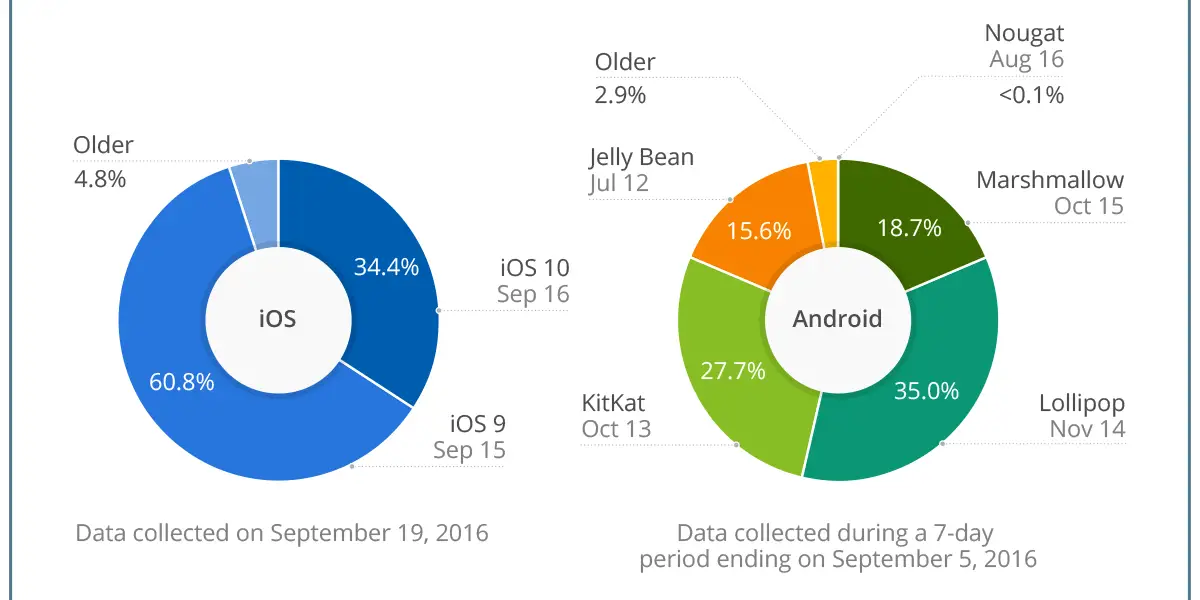
Apple vs. Android: A Comparative Analysis of Mobile Operating Systems
In today’s tech-driven world, mobile operating systems dominate the global market, with two giants standing tall: Apple’s iOS and Google’s Android. The ongoing competition between these two platforms has significantly impacted the smartphone landscape, influencing consumer preferences, app development, and overall user experience. This article aims to provide a comprehensive and SEO-friendly analysis of the strengths and weaknesses of both Apple and Android, offering valuable insights for users and businesses alike.
User Interface and Design
Apple’s iOS boasts a sleek and intuitive user interface that has been carefully curated to offer a seamless and visually appealing experience. Known for its uniformity across devices, iOS ensures consistent user interactions, regardless of the iPhone model. The iconic home screen with its grid of icons and clean aesthetics has been praised for its simplicity.
On the other hand, Android provides a more customizable experience, allowing users to personalize their home screens with widgets, shortcuts, and themes. The freedom to choose between different user interfaces, such as stock Android, Samsung’s One UI, or Xiaomi’s MIUI, gives users the ability to tailor their devices to suit their preferences.
App Ecosystem and Quality
The app ecosystem plays a crucial role in the popularity of a mobile operating system. Apple’s App Store boasts a stringent review process, resulting in a curated collection of high-quality apps. The exclusivity of iOS devices has incentivized developers to prioritize iOS app development, often leading to timely updates and a better overall user experience.
In contrast, Google’s Play Store has a more open approach, which allows for a greater variety of apps, but it also means a higher risk of low-quality or malicious apps. While Android’s user base is larger, this fragmented market can make it challenging for developers to optimize their apps for various device configurations and screen sizes, potentially resulting in an inconsistent experience for users.
Hardware Integration
One of Apple’s key advantages lies in its tight integration of hardware and software. By designing both the operating system and the hardware, Apple can optimize performance and create a seamless user experience. This approach ensures that iOS devices run smoothly and efficiently, even with relatively modest hardware specifications.
Android, being an open-source platform, runs on a wide range of devices from different manufacturers. While this provides users with more choices, it also means that the optimization of hardware and software may not always be as refined as on iOS devices. High-end Android devices often match or even surpass iPhones in performance, but lower-end devices might struggle with resource-intensive tasks.
Updates and Support
Apple’s control over both hardware and software allows them to provide timely updates and support for their devices. iOS updates are generally available to a wide range of compatible devices simultaneously, ensuring that users have access to the latest features, security patches, and bug fixes promptly.
Android updates, however, face challenges due to the involvement of multiple manufacturers and carriers. While Google releases timely updates for its Pixel devices, other manufacturers might take longer to adapt the latest Android versions to their customized user interfaces and hardware configurations. This results in a fragmented update landscape, with some users being left behind on older versions.
Privacy and Security
Apple has long been vocal about its commitment to user privacy and security. iOS incorporates robust security features such as Touch ID, Face ID, and a dedicated hardware enclave to store sensitive data securely. Additionally, Apple’s stringent app review process helps keep malicious apps at bay, making the App Store a relatively safe environment for users.
On the other hand, Android’s open nature has made it more susceptible to security vulnerabilities and malware attacks. However, Google has been actively addressing these concerns in recent years. Android’s app permissions system allows users to control app access to sensitive information, and Google Play Protect continuously scans apps for potential threats.
Integration with Ecosystem
Apple’s ecosystem integration has been a key factor in its popularity. With products like the iPhone, iPad, Mac, Apple Watch, and Apple TV, users can seamlessly transition between devices using features like Handoff, AirDrop, and iCloud synchronization. This level of integration provides a cohesive user experience that keeps users within the Apple ecosystem.
While Android has made efforts to improve integration through services like Google Drive and Google Photos, its ecosystem integration does not match the seamless experience provided by Apple. Android users often rely on third-party apps and services to achieve similar cross-device functionality.
Customization and Flexibility
Android shines when it comes to customization and flexibility. Users have the freedom to tweak various aspects of their devices, including home screen layouts, default apps, and system settings. Android’s open-source nature has also led to the development of custom ROMs, offering even more options for advanced users.
Apple, in contrast, prioritizes simplicity and uniformity. While iOS does provide some level of customization, it is limited compared to Android. This approach may be preferred by users who value a consistent and user-friendly experience, but it might not cater to those seeking deeper customization.
Conclusion
In conclusion, the battle between Apple’s iOS and Google’s Android continues to shape the mobile operating system landscape. Each platform offers distinct advantages and appeals to different user preferences. Apple’s iOS stands out for its polished user interface, curated app store, tight integration of hardware and software, and strong focus on user privacy and security. On the other hand, Android’s openness allows for greater customization and flexibility, a wider range of devices, and a more diverse app ecosystem.
Ultimately, the choice between Apple and Android comes down to personal preference and priorities. iOS is a great fit for users who value a seamless, user-friendly experience and are willing to invest in Apple’s ecosystem. On the other hand, Android suits users who prioritize customization options, want more device choices, and appreciate the benefits of an open-source platform.
Whichever platform users choose, the competition between Apple and Android continues to drive innovation, resulting in better mobile experiences for users worldwide.




